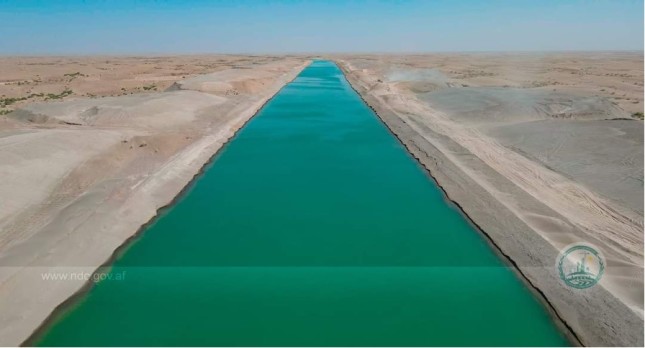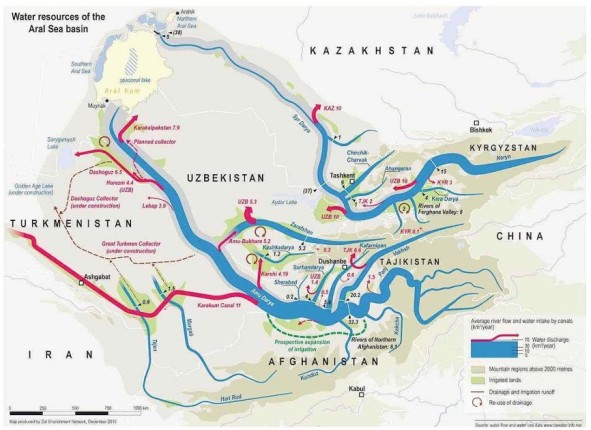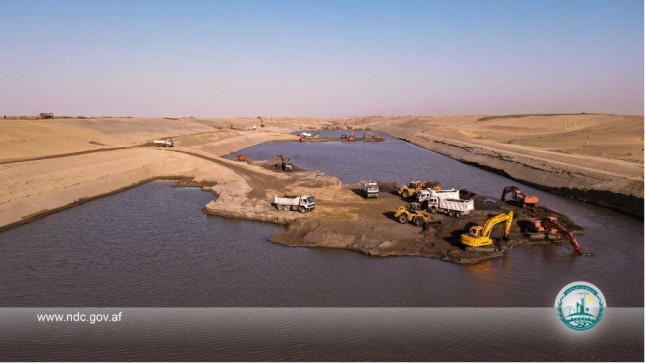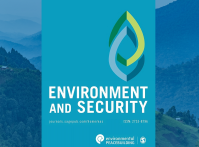-
Charting Complex Currents: The Qush Tepa Canal and Central Asia’s Water
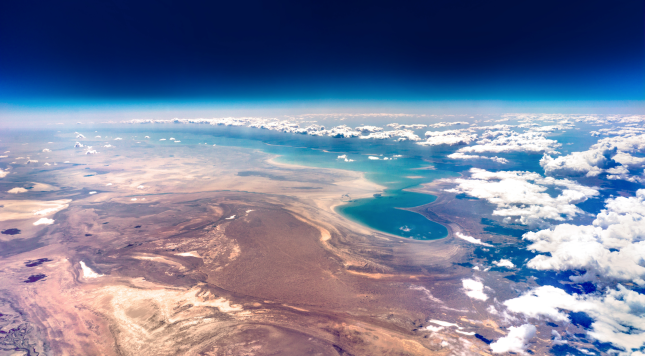
The riparian states of the Aral Sea Basin are experiencing growing water demands, land, and environmental degradation, aging and inefficient infrastructure, and the rapid melting of glaciers. These increasing challenges are compounded by the lack of an effective transboundary water governance system.
Yet a new challenge on the horizon has considerable potential to shake up a largely uncooperative—yet relatively stable status quo: the Qush Tepa irrigation canal. Currently under construction in Afghanistan, this new canal promises to provide jobs in that nation as well as alleviate its severe food security crisis. Yet the Qush Tepa project also significantly increases the potential risk of conflicts in the region.

A new opportunity to improve relations also exists, especially if countries in the region—supported by international actors—intensify efforts to establish an inclusive water governance mechanism. This new structure would recognize the (until now) neglected water rights of Afghanistan, as well as account for environmental needs in the region. Charting this course in the Aral Sea Basin might see the canal as a channel that would preserve and strengthen regional stability.
Agreements That Left Out Afghans
Most of the water from the two major rivers in the Aral Sea Basin (the Amudarya and the Syrdarya) is generated in the highlands. These resources have been—and still are—utilized in economically-powerful downstream regions based on the provisions of the 1992 Almaty Agreement, which evolved from Soviet-era water allocation quotas.
As a southern regional neighbor under Soviet occupation at the time, Afghanistan was kept outside of this arrangement. Yet Afghan water usage was estimated, by Moscow and later by Central Asian states, at 2.1 BCM per year—a total far lower than the 3.85 BCM per year used in Afghanistan as far back as 1965. Protocol 566 (1987) refers to this use as inevitable losses of flow, similar to the losses such as evaporation from the river and reservoirs that also occur.
While Afghanistan’s contribution to the Amudarya is estimated at 30% of its total flow of 61.5 BCM, Moscow’s priority in that era was to ensure water flow to agricultural powerhouses (Uzbekistan and Turkmenistan) to sustain and boost Soviet cotton production. Therefore, the Soviet Union allocated 48.2% and 35.8% of the total annual flow from Amudarya to Uzbekistan and Turkmenistan, respectively, while granting 15.4% and 0.6% to Tajikistan and Kyrgyzstan.
This historical prioritization of economic considerations and water intensive crops such as cotton has come at a tangible environmental cost. Once the fourth largest lake in the world, the Aral Sea has shrunken significantly since 1960, with environmental and health consequences that have impacted the whole region.

Despite the signing of various agreements and the establishment of regional organizations such as the Interstate Commission for Water Coordination (ICWC) and the Interstate Fund for Saving the Aral Sea (IFAS), Central Asian States have so far been unable to escape this legacy and provide sustained and mutually acceptable solutions to the issues at hand—including an equitable seasonal allocation of water and energy. Development of hydropower in upstream countries such as Rogun Dam in Tajikistan and Kambar Ata 1 Dam in Kyrgyzstan has often sparked opposition and threats from downstream countries. Frustrated with a lack of progress in integrating its energy concerns into the existing agreements, for instance, Kyrgyzstan has since 2016 largely frozen its participation in IFAS.
The Aral Sea Today: Water Stress and Competition
Water insecurity is already on the rise in Central Asia, where a third of the region’s population (or 22 million people) lacks access to safe water. Population growth, particularly in cities, will further increase water and sanitation needs. And there’s climate change: temperatures in Central Asia have risen twice as much as compared to global levels, and projection shows an increase of a 2-4 degree Celsius by 2050 for the major part of the region.
Climate impacts will create additional water stress. Glaciers will melt faster, resulting in a short-term surge in waters, and then be followed by a severe reduction of glacier runoff in the longer term. (By some estimates, these reductions will reach 30-40% by the middle of the century.) Moreover, as glaciers in the region recede, a change in the seasonal patterns of river flow is also expected, as peak flows shift from summer to spring, with adverse impacts on irrigation. Increasing temperatures also increase the risk of outbursts from glacial lakes, as well as mudflows and avalanches in highland regions. This will also reduce crop productivity and harm regional food security.
The Qush Tepa Canal, once completed, will only add to the stress on the Aral Basin. It aims to divert around 10-13 BCM from the Amudarya annually, with the highest volume of diversion (approximately 9.5 BCM) occurring in the peak irrigation season from May to August.
A reduction in the Amudarya’s flow will undoubtedly affect downstream regions in Uzbekistan and Turkmenistan. For instance, it will have a significant impact on the cotton industry in both countries—which is an important source of hard currency and employment. Cotton is also an important component of state control in both nations, with profits that flow to the state or to small elites with powerful ties to it.
The canal’s impacts will also be felt tangibly in the Karakalpakstan autonomous region, which is further downstream in Uzbekistan. This region is home to minority Karakalpaks, and has undergone violent unrest over the last two decades.
Turkmenistan boasts the fourth largest gas reserves in the world, but fully 97% of Turkmenistan’s fresh water flows from outside its borders. Yet a large portion of its population is employed in the agricultural sector—even though it adds only 12% to the nation’s economy. And while Turkmenistan is also faced with its own general water shortage, and well-known wastage of water, the nation has invested in turning its deserts green through massive irrigation infrastructures such as Karakum Canal and the Golden Age Lake.
Given that a reduction in flow would threaten agriculture, worsen water shortages, and risk aggravating the socio-economic and environmental situation in a volatile region, how might Uzbekistan and Turkmenistan cope? Both nations would have to adapt to the decreased water flow either by shrinking their irrigation agriculture or increasing water use efficiency. The potential consequences (population displacement, migration, and increasing unemployment rate) could create negative social and economic ramifications.
Reshuffling quotas might also be on the cards. Turkmenistan is 90% reliant on water from Amudarya, so a reduction in the flow would require a complex water quota renegotiation with Uzbekistan and Tajikistan. Prompted by profound concern, Turkmenistan earlier this month hosted the first trilateral summit, where the leaders of three countries emphasized strengthening water cooperation and rational use of water and energy resources while pointing to the potential increase in pressure on the water of Amudarya without any mention of the Qush Tepa canal. Uzbekistan might find that such a reduction adds pressure on other internal water resources, including the Syrdarya—and thus increase tensions with Kyrgyzstan and Kazakhstan.
Qush Tepa: Opportunity or Challenge?
Despite broader regional and international efforts to promote regional cooperation, Afghanistan has largely been kept outside of Aral Sea basin efforts. Decades of war, as well as its seeming inability to utilize shared waters from the Amudarya, and a perception that Afghanistan’s future water use would be limited, have combined to make this so. Also, downstream countries perceive that Afghan involvement might strengthen the positions of the upstream countries or simply add another layer of complexity.
Thus, the construction of the Qush Tepa Canal creates a new set of dynamics for regional water security. First conceived in 1970s, actual work started in 2022. The restored Taliban government has relied on a previous USAID-funded feasibility study. When finished, the 285-kilometer canal will irrigate around 550,000 hectares of land in northern Afghanistan.
The canal project also serves the Taliban’s political agenda. It seeks to project a picture of the government as capable and inclusive, offering benefits to ethnic minorities in northern Afghanistan who are largely absent from the current Taliban power structure. Moreover, the canal project could also increase the Taliban’s control over the northern part of the country, where the first anti-Taliban resistance emerged in the late 1990s.
Yet while the canal offers the promise of development and prosperity for war-torn Afghanistan, it would only exacerbate the already dire water security situation in Central Asia. The projected reduction and changes to flow regime of the Amudarya—as glaciers melt and temperatures increase—further complicate this situation.
Despite financial sanctions, international isolation, and a severe shortage of technical and managerial expertise, the Taliban government is nearing completion of the Qush Tepa’s first phase. The region’s previous experiences with water wastage and the infiltration of salinity into agricultural land have already raised concerns. (Studies show that 70% of agricultural land in the region is salt affected. At 97%, that number is even higher in Turkmenistan.

As a later developing riparian country, Afghanistan is also entitled to a reasonable and equitable share of the water in both the Amudarya and the Syrdarya. The dilemma of being a later developing riparian in the context of a transboundary river basin is not unique to the region. Conflicts between later developing riparians and nations accustomed to prior usage can be found in various international river basins, including the Nile, Mekong, and the Tigris and Euphrates.
International law (including the UN 1997 Water Course Convention) indicates that both existing and potential use should be factors in utilizing international watercourses equitably and reasonably. Yet finding agreement amidst competing interests requires close cooperation among all riparians.
Afghanistan’s engagement within the existing (albeit not very effective) water governance mechanisms, such as IFAS or ICWC, would require substantive changes to the way these mechanisms work. Afghan inclusion was previously perceived as a threat to the interests of the powerful downstream countries, but its use of the Qush Tepa canal for agriculture would perhaps position it to be in favor of irrigation water quotas—and closer to the outlook of downstream riparian countries. Striking a balance might make a comprehensive benefit-sharing agreement plausible. Further, Afghanistan’s energy dependence and food insecurity and the existing trade, transit, and energy regional projects could also provide incentives for all riparians to focus on a broader package of shared interests rather than focusing solely on dividing the diminishing shared resources in pursuance of self-reliance policies.
Seeking a Better Regional Structure
Given the Taliban’s lack of technical capacity, its Qush Tepa project could benefit greatly from technical expertise and support. Yet much of the irrigation infrastructure in Central Asia is in despair, and water efficiency is already low. Uzbekistan (and, to a lesser extent, Turkmenistan) have already engaged with the Taliban over the canal issue due to its potential impacts. Yet bilateral approaches are unlikely to offer the necessary expertise or sustainable and inclusive solutions to the regional transboundary water challenges.
International sanctions against the Taliban, as well as its own political sensitivities, also constrain the prospect of bilateral efforts. Thus, addressing the emerging challenge to regional water security requires a unified regional approach towards Afghanistan, now lacking among the Central Asian countries.
The international community could play a critical role in supporting a new regional stance—including an engagement strategy with the Taliban within a broader regional stability context. Such efforts would not necessarily entail any formal recognition of the Taliban.
Previous efforts to establish an inclusive and sustainable regional water management system did not achieve any tangible results. But perhaps Aral Sea Basin riparians (particularly Uzbekistan and Turkmenistan) will prove willing to pursue their interests in an inevitable arrangement in which Afghanistan also participates.
While Qush Tepa further complicates regional water security, it also presents an opportunity for riparian countries and international actors to reinvigorate efforts to transform the existing regional water governance mechanism into one that is inclusive, effective, and resilient to climate change. It also may provide an opportunity to consider the long-neglected rights of Afghanistan and the environment. The stakes are high. But early international intervention and regional support are critical to addressing regional water security and its potential destabilizing impacts.
Mohd Faizee is a researcher at IHE Delft.
Susanne Schmeier is an Associate Professor at IHE Delft.
Sources: CNN; Crisis Group; Environmental Justice Foundation; Geopolitical Monitor; Konrad Adenauer Stiftung / Stimson; The Third Pole; World Bank
Photo Credit: High altitude aerial landscape of the Aral Sea, courtesy of agpotterphoto.
 A Publication of the Stimson Center.
A Publication of the Stimson Center.

